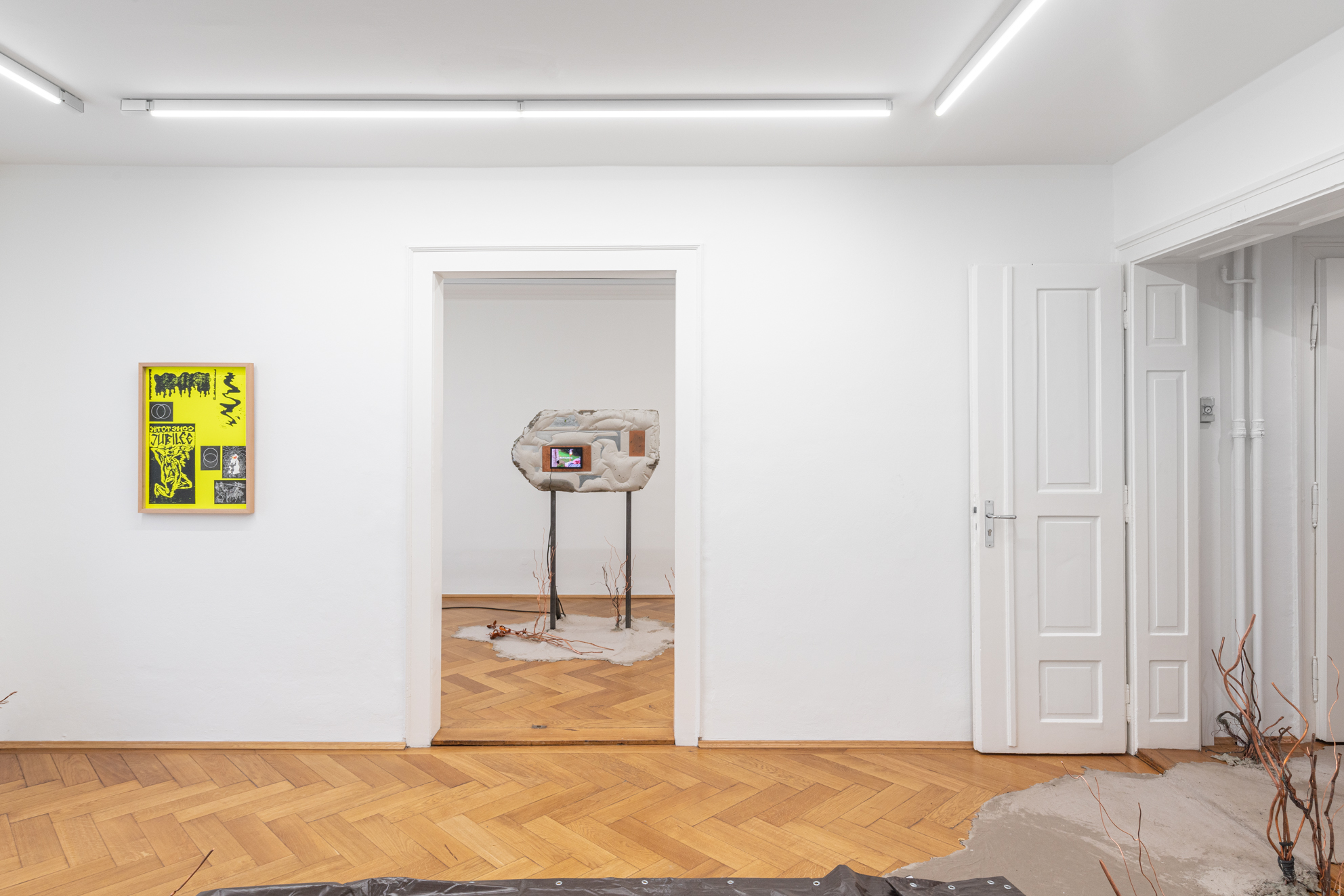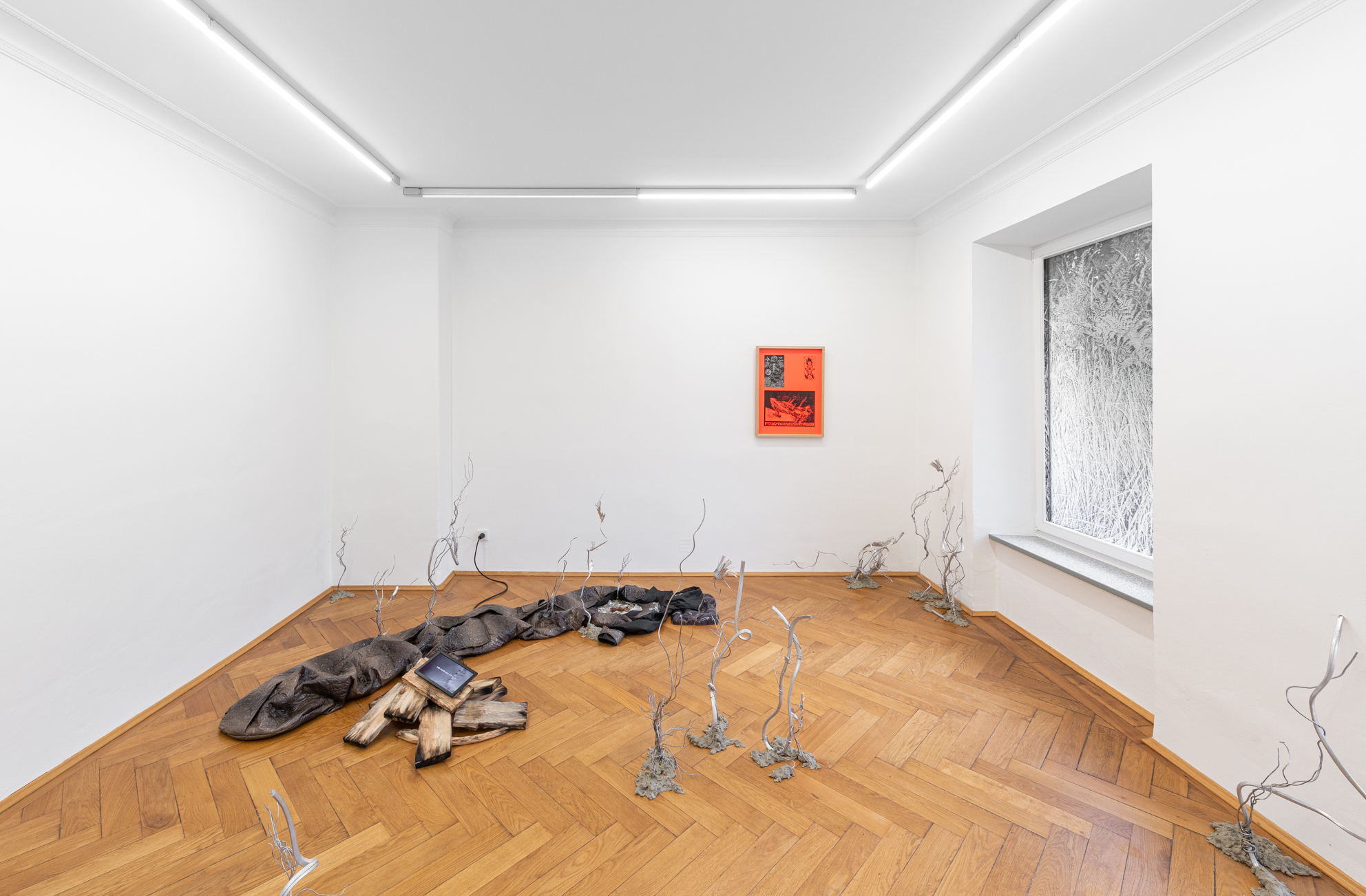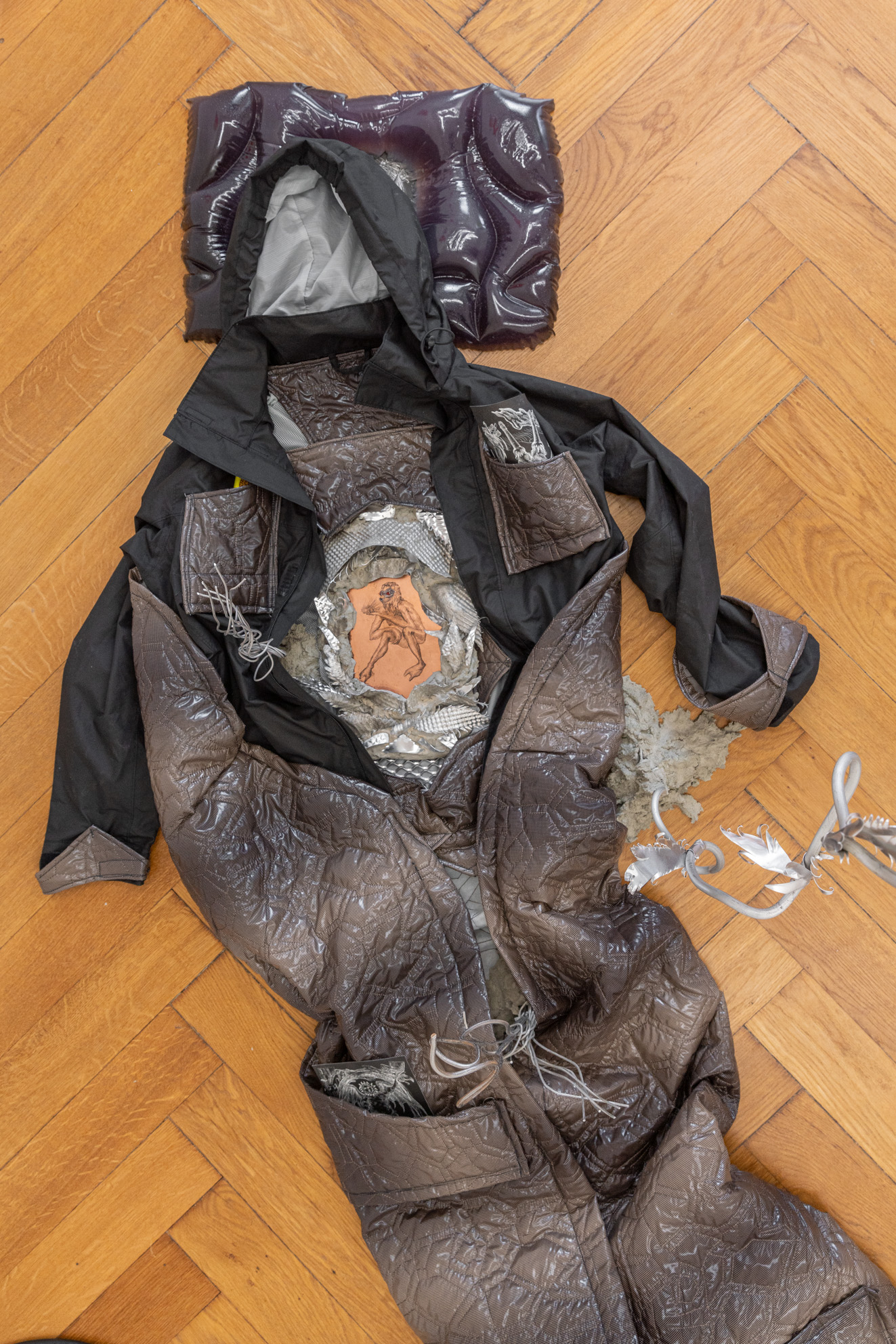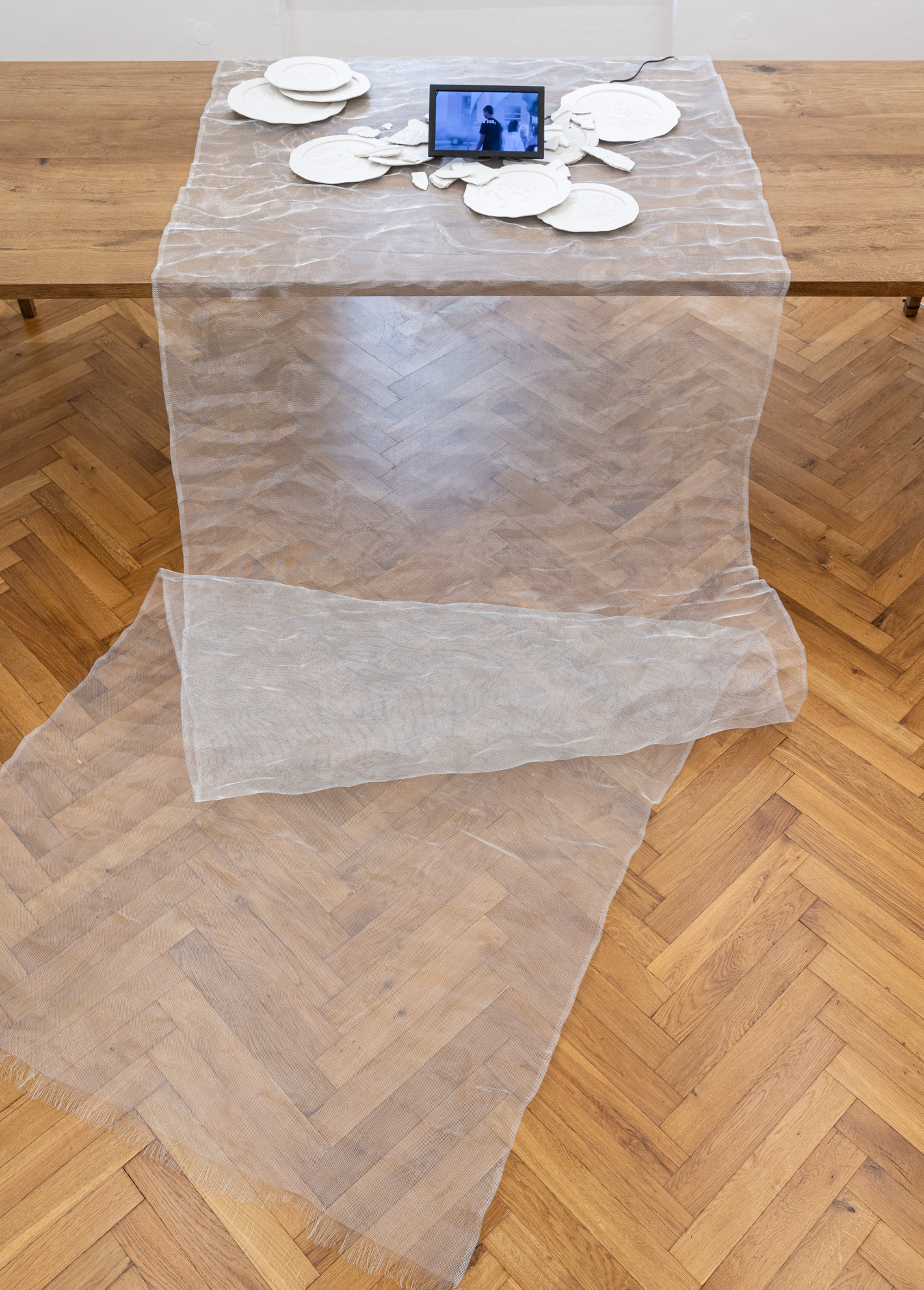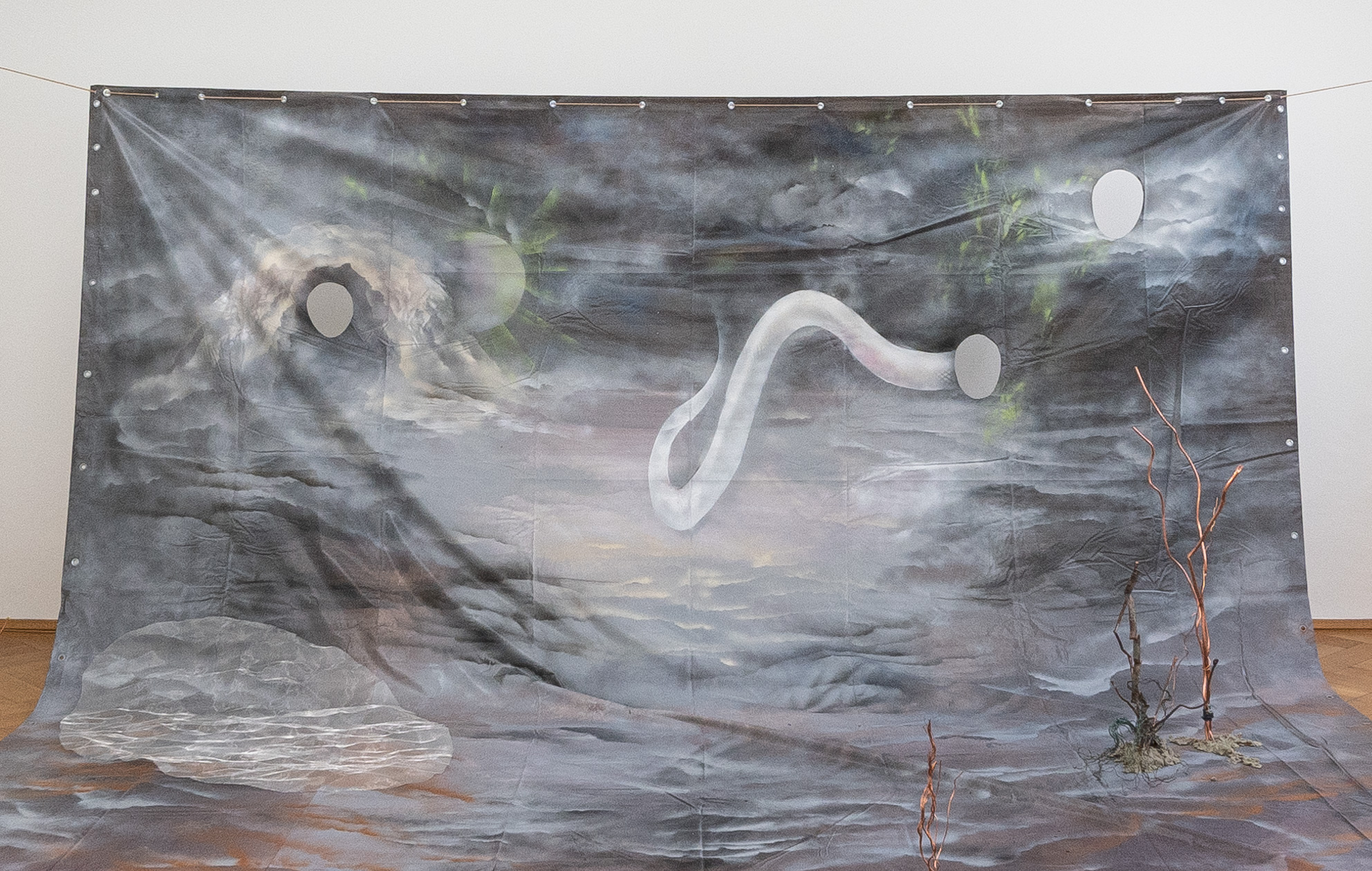
On occasion of her first solo show in Munich, Lithuanian artist Anastasia Sosunova presents a multilayered installation combining sculpture, video, vinyl and woodcut prints with the intent to explore acts of worldbuilding and critically understand the structure behind collective ideals and their dissemination.
The exhibition is the result of the artist’s ongoing fascination and research into real and fictional histories of utopian socialist communities in East Europe and how these can be recontextualised and understood in relation to today’s political struggles of the same geographical areas, and Lithuania in particular. There are two main literary works that the show builds upon: the highly censored novel “Chevengur” by Soviet Russian writer Andrei Platonov and the more recent short story “2017 – A Year of Anniversary” by Lithuanian artist Agnė Jokšė. The former, finished in 1928 but only published in 1988, unfolds in an imaginary town inhabited by ardent supporters of the Communist Revolution who gradually render a supposedly realized place of communism and non-work, a miserable and improbable village. The latter, tells the story of a now centenary socialist non-binary community, settled in Lithuania’s woods a few decades after the October Revolution, from which the main character is exiled and left alone to survive in the forest. Elaborating on the profound ambivalence of both literary works as well as their direct link to the October Revolution and the following propagation of new ideals, Sosunova presents different environments which unfold in the gallery space and its liminal areas: an amusement park where the local customs of an imagined settlement are presented to the (foreign) viewer; a farewell dinner for an exiled member of the community; and some peripheral agglomerations for a basic survival at the outskirts of society. The works appear theatrically staged in the gallery space and become both a backdrop for an imagined non-binary and post-work future society, and a set of visual cornerstones for a world made of better values; while presenting gazes which are outside of it – be these of the viewer or of the imagined exiled member of the community.
Upon entering the first room, vast advertising banners, become mottled landscape for the visitors to pose and embody the customs of the celebrated community; whilst in a adiacent chamber, concrete is rendered puffy and soft, and becomes a nest for a short video offering insights on the local customs. Etching and woodcut prints on bright paper, present a rich mix of symbols related to both communist propaganda and post-apocalyptic visions celebrating the end of the world and the beginning of a new one. A recurring figure in the show is in fact the one of the builder, re-proposed as the symbol of world-building labour and thus revealing a lingering sense of hope for a future made of constructive acts of re-imagination. Resilience animates tufts, leaves and bouquets made of scrap metal that grow sporadically across the rooms, generating a meandering path populated by sculptures made of found materials and resembling survival objects. In another room, for example, the viewer encounters a sleeping bag-jacket embroidered with smuggled images inspired by Christian orthodox iconography and standing next to piled logs, that disclose another video. In this, a bird keeps appearing, tirelessly trying to fly away from a room that keeps it prisoner. The windows are shut, there’s a water tank (another cage?), there’s golden claws scratching a surface and then a digger collecting stacks of scrap metal. Despite the absence of sound, if one could imagine one it would be shrilling; and a poem overlaid on the images asks “how do we repurpose all this disposed abundance” – “we’ll figure it out as we go”. A similar pattern appears in the last room of the gallery, where a metallic tablecloth covers the dinner table for a farewell party. The main meal is another video, showing politically charged imagery of recent extremist manifestations in Lithuania among peaceful sunsets and carnival parades. This time, the poem overlaying the images of the video, raises personal and political questions around the current collective need for radical change.
Making use of propagandistic means of persuasion such as leafleting, the hammering repetition of slogans, advertising and other forms of entertainment, and borrowing from politically charged 20th century Lithuanian imagery as well as eschatological iconography, Sosunova makes the effort to rethink visions for the future while exposing potential totalitarian challenges that inevitably come with the diffusion of new collective thinking. Apparent opposite interpretations coexist in the show, presenting both a utopian society and someone living outside of it, overcoming binary thinking and inventing new visual languages that come from multiple perspectives. Materially, the coexistence of re-used industrial materials and traditional craft techniques expose at the same time the attributes of a capitalist landscape typically disposed of after one season, the joy of re-inventing and re-vitalising and the potential artificiality of something that it is believed in, but not really put into question. A repurposing approach emerges also within the videos, which collate material from the artist’s personal archives of both her phone and camera roll and juxtapose a personal and intimate dimension, with a broader collective one, made of dreams about revolutionary changes and fears of the same. The poems that accompany the films tell, in fact, about revolution and togetherness, and explore ideas around the politics of being a community quoting the two main texts Sosunova refers to in the show, and other authors – from Toni Morrison to Jean-Luc Nancy, Maurice Blanchot or Jack Halberstam to name a few. Having everything in the show handcrafted, hand-shaped, cast, painted, printed and carved, Sosunova expresses her faith in craft and in forming a personal connection with the process of production, as a means for activating post-work ideas and escaping alienation.
The show has an overall carnivalesque mood, which explores the magic potential of creating worlds through evocation, embodiment and bewilderment, used as an aesthetic strategy to imagine impossibly contradictory situations that reveal the complexity of life. In his most recent book “Wild Things, The Disorder of Desire” (2020), Jack Halberstam explains that the notion of bewilderment comes from pre-colonial ideas of space, orientation and navigation and refers to an immersive sense of being lost, or standing outside a system of knowing. It is significant to notice that the sense of bewilderment is often associated with woods, which are themselves not a neutral space being equally enchanting and horrific, and that also appear as the main setting of the exhibition as well as the stories it refers to. Perhaps such a notion can encapsulate the core of Sosunova’s immersive installations; observing curiously how communities and identities originate, subsist and come undone; while proposing a blend of epistemological systems which exist in the shadow of those considered meaningful. Putting together all the elements populating the show becomes a puzzling challenge for the viewer, opening to multiple questions rather than narrowing to single solutions. But there is no need to worry; as the title suggests, the show is a Jubilee, an invite to a wild celebration, a rite of passage to a new reality while mourning the old and dreading the uncertainties of the unknown. In a time when the need of re-inventing the world is an urgent matter, this show is a metaphor of worldbuilding itself, gazing towards a place for fluid emancipation, queerness and complexity.
Quoting from Anastasia Sosunova and her videos:
the worst time
the best time
spread the word
every day is my jubilee
Caterina Avataneo is an independent curator based between London and Turin.



